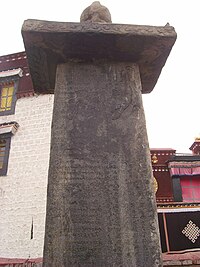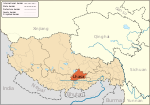Tang–Tibet Treaty Inscription
Appearance

The Tang - Tibetan Empire Treaty Inscription (Tibetan: གཙུག་ལག་ཁང་མདུན་གྱི་རྡོ་རིངས་, Wylie: gtsug lag khang mdun gyi rdo rings; simplified Chinese: 唐蕃会盟碑; traditional Chinese: 唐蕃會盟碑; pinyin: Táng-Bō Huìméng Bēi) is a stone pillar standing outside the Jokhang Temple in Lhasa, Tibet Autonomous Region, China. The inscription is written in both Tibetan and Classical Chinese, concerning the Changqing Treaty between the Tibetan Empire and Tang Empire in A.D. 821/823.[1] Amy Heller's book Tibetan Art describes it as one of the most important treaties between the Tang and Tibetan Empire.[2] Inscription states the relationship of Tang and Tibetan Empire as uncle and nephew of same family. [3]
| Chinese name | |||||||
|---|---|---|---|---|---|---|---|
| Traditional Chinese | 唐蕃會盟碑 | ||||||
| Simplified Chinese | 唐蕃会盟碑 | ||||||
| Literal meaning | Tang-Tibet Alliance Monument | ||||||
| |||||||
| Tibetan name | |||||||
| Tibetan | གཙུག་ལག་ཁང་མདུན་གྱི་རྡོ་རིངས་ | ||||||
| Literal meaning | The stele in front of the Jokhang Temple | ||||||
| |||||||
References
[edit]- ^ Richardson, Hugh, "The Sino-Tibetan Treaty Inscription of A.D. 821/823 at Lhasa," Journal of the Royal Asiatic Society 1978, no.2, pp.137-162.
- ^ Heller, Amy (1999). Tibetan Art: Tracing the Development of Spiritual Ideals and Art in Tibet, 600-2000 A.D. Milano, Italy: Jaca Book. p. 49. ISBN 8816690046. OCLC 42967492.
- ^ དབོན་ཞང་གཉིས ༎ ཆབ་སྲིད གཅྀག་དུ་མོལ་ནས ༎ མཇལ་དུམ་ 舅甥二主 商議社稷如一 The two masters, uncle and nephew, discuss the unity as one country
Reading
[edit]Wikisource has original text related to this article:


